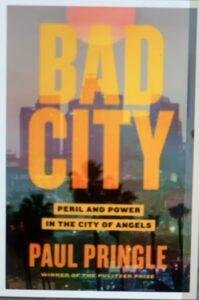Paul O’Connor reviews a disturbing true-crime story that shines a light on the dark side of some usually well respected institutions.
Reviewed by Paul T. O’Connor
BAD CITY: PERIL AND POWER IN THE CITY. By Paul Pringle. Celadon Books. Hardcover. 304 pages. $29.99, hardcover. Also available from Macm illan Audio, read by Robert Petkoff. 9 hours, 48 minutes.
illan Audio, read by Robert Petkoff. 9 hours, 48 minutes.
At the University of Southern California’s Keck School of Medicine, opthalmologist Carmen Puliafetto was a superstar. As dean for the previous decade, he had raised enormous amounts of money through donations and grants and helped lift the school’s national standing, both essential for a university determined to climb into the highest ranks of American academia.
Outside of his glittering life at Tinsel Town’s leading private university, however, Puliafetto was also a heavy drug user and a sexual deviant.
In Bad City, veteran Los Angeles Times investigative reporter Paul Pringle details the investigation he and a team of reporters conducted in 2017-18 to expose Puliafetto’s misdeeds, stonewalling by police and the university, and his own newspaper’s internal conflicts regarding the story’s publication. Almost as a late throw-in, Pringle details the sexual misconduct case of a USC student health doctor, gynecologist George Tyndall, a scandal that the university appears to have deliberately overlooked. In the end, only the reporters come out of Bad City looking good.
Puliafetto’s downfall begins with a day spent with his mistress, someone approximately 45 years younger than he. She has overdosed in a fancy hotel room registered to the doctor, and both the police and an emergency medical team have been called. One thing leads to another, there are the usual police and university dismissals of the concerned hotel employee who reports the doctor’s involvement in the overdose, and then a connection to someone who tells the story to a reporter, Pringle.
From there, it is one of those true-crime stories that is too hard to believe. A physician of national stature, earning $1 million a year from USC alone, is purposely keeping a young woman addicted to drugs, undermining the very residential treatment programs she enters by smuggling drugs to her. Puliafetto has no bounds in his evil-doing. When he meets the woman’s younger brother, a high school student, he gets that boy hooked on drugs too.
Once Pringle gets onto the story, he requests information from Pasadena police, where the original overdose occurred, and USC. Both stonewall him. Puliafetto is an important asset to both the university and the community. He has his protectors.
As his research gains momentum, Pringle comes to believe that Puliafetto’s protection might extend to his own newspaper. His editors, by habit slow to publish investigative pieces, are, by his account, throwing one set of roadblocks after another in the way of publication to protect their favorite school. The book becomes as much an expose of what Pringle, in excruciating detail, sees as a newsroom scandal as it is of the more serious USC, police and Puliafetto scandals.
His former editors, to this day, months after publication, continue to vigorously deny his allegations, claiming their reluctance to publish the story when Pringle first considered it complete, and their insistence on more information, led to a much stronger story in the end.
As a retired newspaper guy, I found the inside newsroom story both fascinating and reminiscent of disagreements I had with editors who were slow to publish. But I never experienced anything on the scale that Pringle alleges, nor did I ever fear that my editors were in cahoots with the bad guys.
I wonder if, by reporting the newsroom angle to the extent that he did and by alleging misconduct by his editors, Pringle did not undermine the very newspaper whose credibility supported the much bigger story he was writing about USC.
Bad City is an indictment of institutions we depend on for the highest in ethical behavior: our universities and their medical schools, the police, and an independent press. It’s just more bad news in a year, a decade it seems, of bad news.
Pringle’s writing is clear and concise. He tells his story logically. I listened to the audiobook, and Robert Petkoff’s narration is very capable.
USC has been rising in the national rankings of private universities for years, but it has also been involved in a number of serious scandals, most notably the athletic department’s accepting of bribes to help the children of wealthy families gain admission.
This book, if widely read, certainly won’t help USC build the academic prestige its leaders so strongly covet.